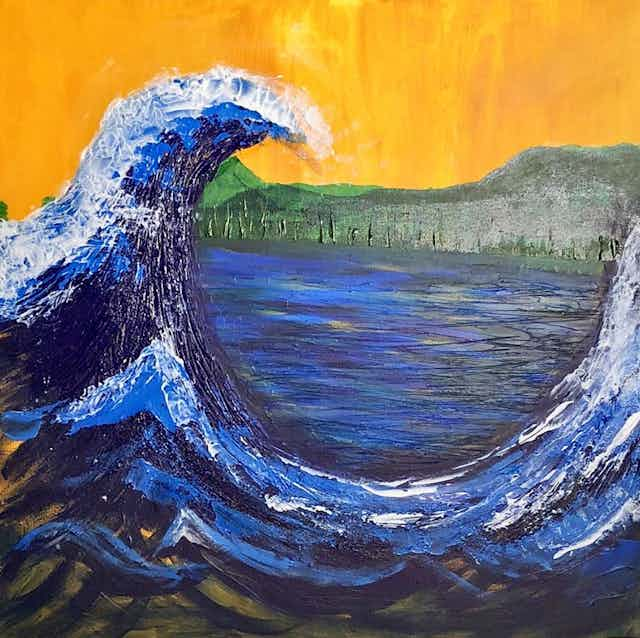The Development of Trump Art: From Very Early Reviews to Contemporary Viewpoints
The Development of Trump Art: From Very Early Reviews to Contemporary Viewpoints
Blog Article
Beginning on a Visual Journey With the Lyrical Interpretations of Nature in Impressionist Landscapes
Each brushstroke, each play of light and shadow, and each color option in their works talks volumes regarding the musicians' deep link to nature and their capability to translate its appeal onto the canvas. As we explore the lyrical interpretations of nature in Impressionist landscapes, we are invited to immerse ourselves in a world where reality and feeling intertwine, offering a glance into the musicians' extensive gratitude for the all-natural world.
The Captivating Brushstrokes of Claude Monet
Claude Monet's mastery of brushstrokes transcends simple strategy, imbuing his landscapes with a heavenly quality that enthralls and mesmerizes visitors - trump art. His innovative use color and light, incorporated with his unique brushwork, develops a sense of activity and life within his paintings. Monet's prominent series of jobs portraying water lilies and his legendary haystacks showcase his capacity to capture the fleeting results of light and environment

Enjoying Light and Darkness With Camille Pissarro
Symbolizing a comparable reverence for the interplay of light and darkness, Camille Pissarro's artistic vision unfolds as an unified exploration of the environment's luminous nuances. Pissarro, a vital figure in the Impressionist motion, masterfully captured the vibrant relationship in between light and shadow in his landscapes. His skilled usage of color and brushwork enabled him to share the refined shifts in light that define different times of day and periods.
Pissarro's paints usually feature dappled sunlight filtering system with fallen leaves, casting intricate patterns of light and shadow on the earth listed below. In jobs such as "Hoar Frost, the Result of Snow, Pontoise," Pissarro skillfully shows the crisp brightness of winter season sunshine compared with the trendy darkness that specify the snowy landscape. By embracing both light and shadow in his structures, Pissarro invites visitors to immerse themselves in the natural beauty and transient impacts of light in the world around them.

Via Pissarro's works, we are advised of the transformative power of light and darkness, inviting us to stop briefly and appreciate the short lived minutes of beauty present in the everyday landscapes that surround us.
A Symphony of Colors by Edgar Degas
Edgar Degas orchestrates a dynamic symphony of colors in his masterful artworks, infusing his compositions with a dynamic interplay of hues that captivate the audience's look. Known mainly for his ballet dancers and intimate scenes of Parisian life, Degas expertly manipulated colors to convey mood and motion in his paints. trump art. His use vibrant, different shades and refined tonal variants developed a i was reading this feeling of deepness and vibrancy within his works
Degas' color palette usually included abundant blues, deep environment-friendlies, and cozy oranges, which he applied with confident brushstrokes to capture the significance of his topics. Whether depicting a ballerina mid-performance or a group of close friends conversing at a coffee shop, Degas' shades not just illustrated the scene however likewise evoked a feeling of feeling and energy.
Furthermore, Degas' experimentation with light and shadow included an extra layer of complexity to his color structures, improving the overall ambience of his paintings (trump art). Through his skillful adjustment of color, Degas created a visual symphony that remains to resonate with visitors today
Discovering Nature's Calmness With Berthe Morisot
Berthe Morisot's artistic vision supplies a tranquil departure from the vivid shade symphonies of Edgar Degas, as she catches the serenity look at this site of nature in her expressive landscapes. Understood for her delicate brushwork and intimate representations of daily life, Morisot's landscapes exhibit a sense of tranquility and harmony.
Morisot's paintings commonly include soft, soft tones that convey a sense of peace and tranquility. Her works, such as "The Cradle" and "Summertime's Day," display her ability to capture the refined appeal of nature in a means that is both reflective and soothing to the audience.
Unlike a few of her Stylist counterparts who concentrated on vibrant compositions and strong shades, Morisot favored to create gentle, reflective scenes that welcome the visitor to mirror and stop. Through her masterful use light and darkness, Morisot creates a sense of harmony that reverberates with the viewer on a deep emotional level.
The Emotional Landscapes of Vincent Van Gogh
Vincent Van Gogh's landscapes clearly communicate a deepness of feeling through their dynamic brushwork and expressive usage of shade. The Dutch post-impressionist musician is renowned for his capacity to record extreme and raw emotions in his paints, transcending conventional representations of nature. Van Gogh's troubled personal life, marked by mental wellness battles, greatly influenced his art, infusing his landscapes with a sense of anxiousness, sorrowful, or exuberance.
In works such as "Starry Night" and "Wheatfield with Crows," Van Gogh's swirling brushstrokes and dynamic color choices evoke a profound emotional response from audiences. The stormy skies and agitated landscapes in his paintings reflect his inner turmoil and emotional turbulence, inviting viewers to look into the intricacies of his psyche.
Van Gogh's special visual language, defined by overstated viewpoints and bold use of color, develops landscapes that reverberate with audiences on a deeply emotional level. With his art, Van Gogh invites us to see nature not equally as an external truth but as a mirror of our innermost sensations and emotions.
Conclusion
To conclude, the impressionist landscapes of artists such as Claude Monet, Camille Pissarro, Edgar Degas, Berthe Morisot, and Vincent Van Gogh provide a distinct and exciting visual interpretation of nature. With their use of brushstrokes, color, feeling, and light, these musicians have actually produced a symphony of images that stimulate a sense of calmness and beauty in the all-natural world. Their jobs continue to motivate and captivate viewers with their lyrical analyses of the landscapes my explanation around us.
Each brushstroke, each play of light and darkness, and each color selection in their works talks quantities regarding the artists' deep link to nature and their ability to equate its elegance onto the canvas. His ingenious usage of shade and light, combined with his unique brushwork, develops a sense of motion and life within his paints. His proficient usage of shade and brushwork permitted him to convey the refined changes in light that specify different times of day and seasons.

Report this page